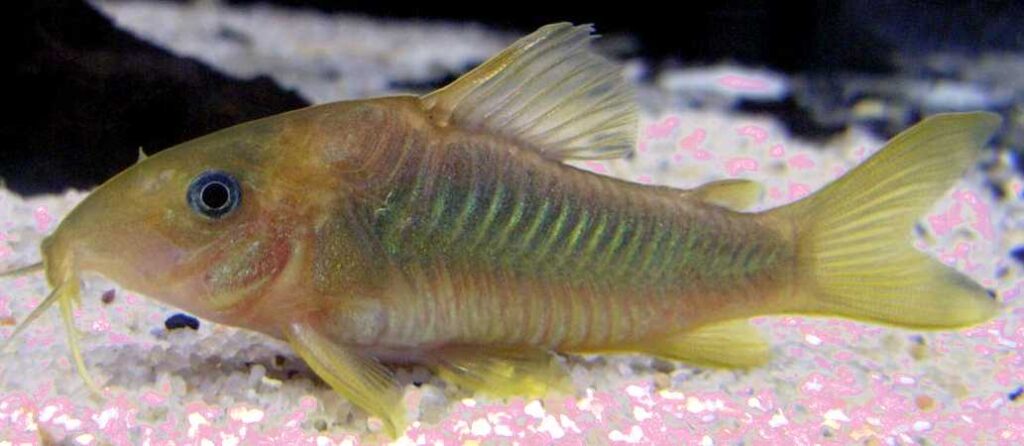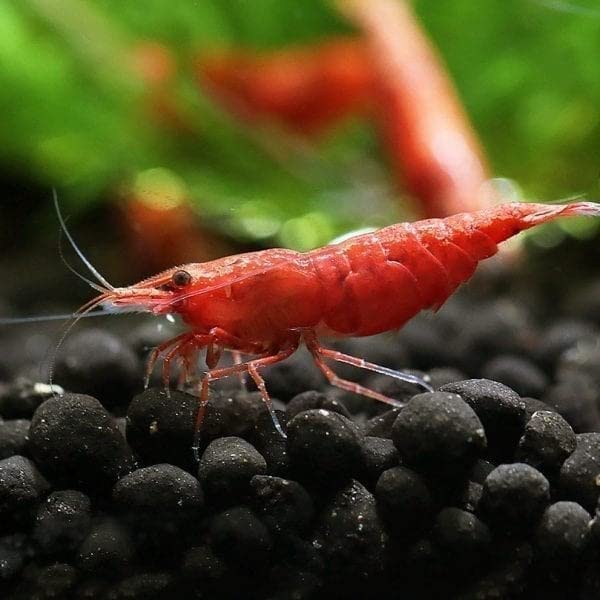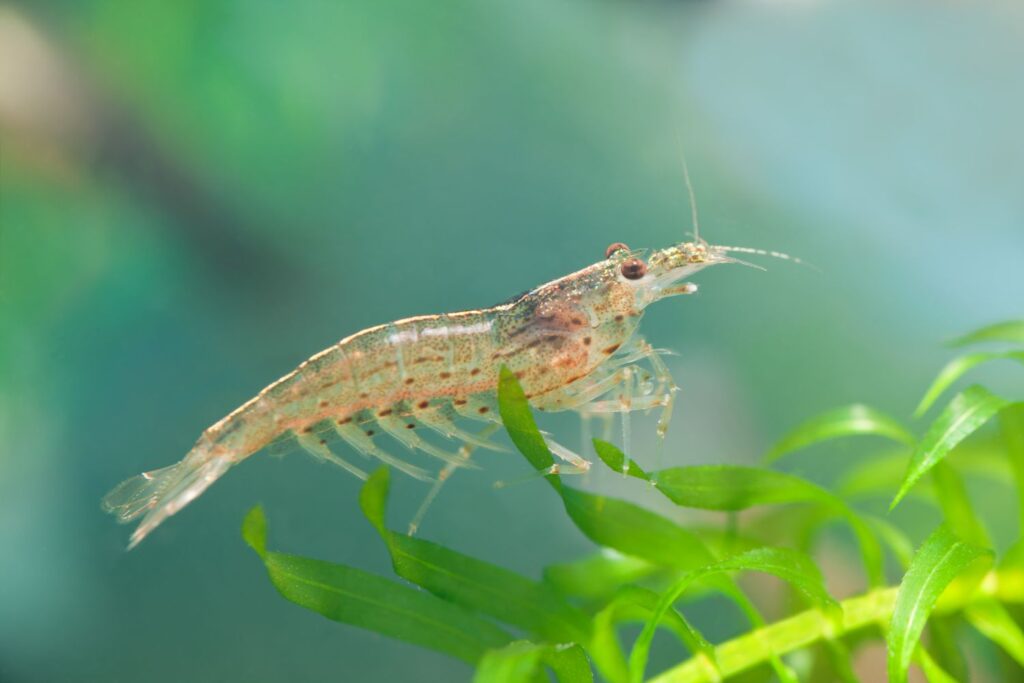Choosing the best fish for a 5 gallon tank can be tricky, but thankfully there are plenty of options available to fit the size and space constraints. Here’s a list of some of the best fish for 5 gallon tanks, complete with additional information and care guides for each species:
- Sparkling Gourami,
- Betta,
- Neon or Cardinal Tetra,
- Corydoras Catfish,
- Guppy,
- White Cloud Mountain Minnows,
- Harlequin Rasbora,
- Cherry Shrimp,
- Amano Shrimp
How to choose the best fish for a 5 gallon tank
1. Select small fish that do not exceed 2 inches in size. Smaller fish place less strain on the tank and will remain small enough that they do not need to be rehomed or upgraded. Good choices for a 5 gallon tank include variety of tetra species, mountain minnows, guppies, rasboras, and White Cloud Mountain minnows.
2. Choose docile fish that can peacefully coexist in a small space. Many small, active fish like neon tetra and platy may look attractive but should not be included in a tank this size because they require more space. Peaceful, schooling fish like neon tetra, black skirt tetra, pygmy cories, or dwarf Corydoras are a much better choice.
3. Avoid aggressive fish. 5 gallon tanks are too small to keep larger, more aggressive species such as cichlids and goldfish. In addition, even with the right fish, you should avoid adding more than three fish to the tank to avoid aggression and overstocking.
4. Select species with similar water requirements. Since 5 gallon tanks are so small, it’s important to make sure all the fish in the tank have similar water requirements such as pH, temperature, and hardness. A dramatic difference in water chemistry can lead to stress and disease in the tank.
The best community fish for 5 gallon tank
1. Sparkling Gourami
The Sparkling Gourami is known for its tiny size, which makes it easy to keep and house in a modest tank. This fish species has an unforgettable glittering pattern when kept in large schools. It reaches up to only half an inch in size, making it one of the smallest species of fish to keep. This fish boasts a colorful composition of polka-dotted fins, stripes of red, and a bright blue eye, making it a sight to behold. As an active species, they can be seen zooming around the tank to get their required daily exercise.

Sparkling gouramis are a small fish that can reach 1.6 inches long. They have bright, colorful bodies with red, green, and blue hues, and can make a croaking sound with their pectoral fins. On top of their exotic bodies, their eyes appear blue and their tail fins shimmer from a rainbow of colors. It may be difficult to sex them, but males have red spots by the line down their body while female spots are less vibrant.
The fish are quite hardy, meaning they can adapt to somewhat poor water conditions and don’t need strong currents in the tank. They also require hiding places, dim lighting, and an aquarium with plenty of space between the water and the top. An ideal water temperature for them is 75-80 degrees Fahrenheit and a pH of 7 or less. Although the gouramis are not schooling fish, they can still be kept in small groups when mates are properly chosen.
Bettas may be too aggressive for them, but non-aggressive fish may be better choices.
Gourami’s can consume flakes, live or frozen foods and should be fed once or twice daily to provide nutritious food for your fish in order for them to stay healthy.
2. Betta Fish (Siamese fighting fish)
The Betta fish, also known as Siamese Fighting Fish or simply Betta (its genus), is a popular and elegant tropical freshwater fish that is often kept in home aquariums. In their natural habitat, these fish inhabit areas in countries like Cambodia and Thailand, such as rice paddies and still water canals. Wild Betta fish have shorter fins and dull green or brown coloration, which is different from the ones found in pet stores, which come in various sizes and colors. Betta fish are a great first pet for teaching children responsibility, as they are inexpensive to buy and take care of. Male and female Bettas look very different, with males having longer and more beautiful fins, while females are smaller and have shorter fins. With proper care, Betta fish can live for 2 to 4 years; some owners have even reported lifespans that extend into the teens!

Betta fish will do best if you only have one betta male and one female betta fish per a tank or you will find that they may harass and harm each other. Beta fish are a only species tank there are not very many success stories of experienced fish keepers being able to keep betta fish a small tank with other fish species.
5. Cardinal Tetra
The cardinal tetra is my go to pick for a community fish that prefers to hang out in the middle of the tank, they prefer to stay in schools so it is always best to make sure you have at least four to six in your tank.

The cardinal tetra is a popular and pretty fish often kept in community fish tanks, this small fish is known for its bright blue and red stripes along its body, making it a beautiful addition to a clean tank with a dark background. Cardinal tetras are peaceful and are best kept in a tank with other small, friendly fish.
Taking care of cardinal tetras is not difficult, making them a good option for new fish tank owners while they are a tough fish that can handle life in a tank and will do well with proper filtration and water quality. Neon tetras like water that is between 72-82°F and have a pH between 6.0-7.0. They eat a mix of things, including flakes, pellets, and small live or frozen foods.
When kept in the right environment, cardinal tetras are lively and social, adding a pop of color to any tank. With their peaceful nature and easy care, neon tetras are a great choice for a 20-gallon tank and will fit in well with other similarly sized fish.
2. Cory Catfish
Cory catfish, also known as Corydoras, are a popular species of tropical fish that do very good in community aquariums. These small, bottom-dwelling fish are known for their gentle and peaceful nature, and for keeping the bottom of tanks clean, making them an ideal addition to a community tank. Cory catfish have a distinctive, armored body with hard spikes and come in a variety of colors, that can include albino, spotted, green, and black.

Taking care of Cory catfish is easy because, Cory catfish are hardy and easy to feed, making them a good choice for both beginner and experienced aquarists. They are well-adapted to community life and thrive in a well-cycled tank with proper filtration and water quality. Cory catfish prefer water temperatures between 72-78°F with a slightly acidic to neutral pH between 6.0-7.5. They are omnivores and will feed on a variety of foods including flakes, pellets, and small live or frozen foods.
Cory catfish play an important role in maintaining the health of an aquarium by scavenging for food and cleaning up waste. They are also active and social fish that will add both interest and liveliness to a community tank. With their peaceful nature, hardiness, and ease of care, Cory catfish are an excellent choice for a 20-gallon community tank and make an ideal addition to any community of similarly sized fish.
9. Guppies
Guppy fish are an incredibly popular freshwater fish in the aquarium scene, sporting gorgeous tailfins filled with color! Low-maintenance and beginner friendly, these fish have a minnow-like profile with a pointed snout and upturned mouth. With luck and genetics, the guppy fish lifespan can be between two and five years, with adults reaching up to two inches in length. Appropriate tank size would be at least a five-gallon tank, but preferably a 10-gallon tank or larger. The best environment for guppies would be one with a water temperature of 64°F to 84°F, pH level of 7.5 to 8.0, and water hardness of 8 to 12. When it comes to decorations, guppies aren’t picky and prefer natural items whenever possible.

Guppy fish are an ideal choice for those looking to start their own fish-keeping tank, as they are well-suited to peaceful multi-species tanks. These small fish possess vibrant fan-like tails in a variety of colors, making them an aesthetically pleasing addition to any aquarium. Guppies tend to swim towards the top of the water and do best in tanks with plenty of vegetation. Furthermore, breeding is easy, since guppies are livebearers and the fry are born fully-formed.
6. White Cloud Mountain Minnows
White Cloud Mountain minnows are an incredibly popular fish for 5 gallon tanks, and their name is derived from the White Cloud Mountain in China – the location in which they were first discovered. Unlike many fish in the trade, this species is not tropical and actually prefers cooler temperatures to thrive; however, they can survive in warmer waters for a short time.

The best way to form a thriving community is to create a cool-water habitat filled lush with plants for the White Cloud Mountain minnows to explore. They naturally skim the surface of the water, so making the environment slightly more shallow may help the fish flourish and extend their lifespan. Luckily, their affinity for cooler temps makes them easier to manage than some of their tropical counterparts.
4. Harlequin Rasboras
The peaceful, 2-inch Rasbora is ideal for beginner fish keepers. These fish feature an eye-catching orange body with a black triangular patch that adds to its attractive appearance. To ensure a healthy and happy school of Rasboras, it is recommended to buy at least six. These gentle fish get along with other tankmates, including Bettas, and provide great exercise and enrichment for them as they’ll attempt to chase the Rasboras without much success. To learn more about caring for Rasboras, take a look at our full care guide.

The Harlequin Rasbora is a fish with an orange-pink body and a large, triangular black pattern on its back, extending from the midpoint of its dorsal fin towards its caudal peduncle. The tail fin is red on the outer rays and hyaline on the inner part. The pectoral and pelvic fins of the Harlequin Rasbora are found in a common cyprinid pattern, the pectoral fins sitting behind its operculum, and the pelvic fins forward of the dorsal fin.
A mature Harlequin Rasbora measures up to 2 inches (5 cm) in length. Males tend to have a slightly bigger black patch and a more rounded marking at the anal fin while ripe females have a fuller body outline.
Species of fish similar to the Harlequin Rasbora are Trigonostigma espei and Trigonostigma hengeli, which were once considered subspecies. These fish have a more slender body shape, and the black marking is replaced by a horizontal strip tapering to the caudal peduncle, thickened and extended below the dorsal fin. This marking pattern is also known as a lamb chop, due to its resemblance to the cut of meat.
2. Cherry Shrimp
Cherry shrimp are a popular, eye-catching continue reading aquarium pleco that make a great addition to small tanks. Notr only are they visually appealing with their vivacious hues, but they also help keep tanks clean by devouring algae. Plus, they have minimal care requirements, making them the perfect inhabitants for beginners and experienced aquarists alike.

Their diminutive size makes them an ideal choice for nano and pico tanks, but they can thrive just as easily in larger tanks as long as they have the right environment. Because they only grow to be approximately one inch long, they need a tank that’s at least 5+ -gallons. Even better, try a 20-gallon tank that has plenty of room for them to explore and roam around. Be sure to provide your cherry shrimp with plenty of surface vegetation and hiding places such as driftwood, plastic plants, rocky caves, and plastic flowerpots. This will give them plenty of places to forage for food, rest, and hide from more aggressive tank mates. Adding some dark substrate to the bottom of the tank will create a natural-looking habitat as well as help promote better water quality.
Cherry shrimp also require pristine water conditions if they’re to stay healthy. How to set up a shrimp tank. Ensure that the pH levels remain stable and at the right range, which should be between 6.5 and 8.0, and that the temperature is kept between 68°F and 78°F. Ammonia and nitrites should both be at zero, while nitrate levels should be under 10 ppm. Regularly changing at least 25 percent of the tank’s water will help keep everything clean and safe. Cherry shrimp also need rich algal growth to indulge in. This can be achieved by introducing some live plants to your tank and adding some extra fertilizer to encourage the growth of algae. It’s possible to keep cherry shrimp in small tanks, but it’s important to remember that they still require an ideal habitat and environment in order to stay healthy. With the right setup, however, these tiny invertebrates can be an extremely rewarding addition to your aquarium.
9. Amano shrimp
Amano shrimp are a favorite among freshwater aquarium owners everywhere. People love these little critters because they’re very easy to take care of and are peaceful (no fighting for food or territory!). They’re quite active and intriguing, too—always up to something interesting to watch. Plus, they’ll help with algae problems in your tank, removing any excess that builds up.

Setting up a tank for Amano shrimp is fairly straightforward. They need a 5-gallon tank and prefer a sandy substrate. You should also include plenty of hiding spots and surfaces in the tank. Live or artificial plants, rocks, and driftwood are all great additions that Amano shrimp will love. In terms of lighting, a low setup will be more than enough. Amano shrimp also need a heater to help maintain a stable water temperature of 70-75°F. They also prefer a more alkaline pH level between 7.0-7.8, and the water should be change once a week to keep the levels in check.
Amano shrimp love to snack on algae, so keep some in the tank for them to feed on. When it comes to caring for Amano shrimp, you need to refrain from overfeeding them. An excess of food can cause cloudy water—this is especially true if you use freeze-dried or flakes. If you opt for a high-quality pellet food, then you can feed your Amano shrimp once or twice per day.
As a general rule, be sure to remove any uneaten food to prevent your water from getting murky. Amano shrimp are a great addition to any tank. By learning the proper care and maintenance strategies, you can create an ideal environment for your shrimp and watch them thrive. If you are looking for a low maintenance aquatic friend, then it’s worth considering an Amano shrimp!











